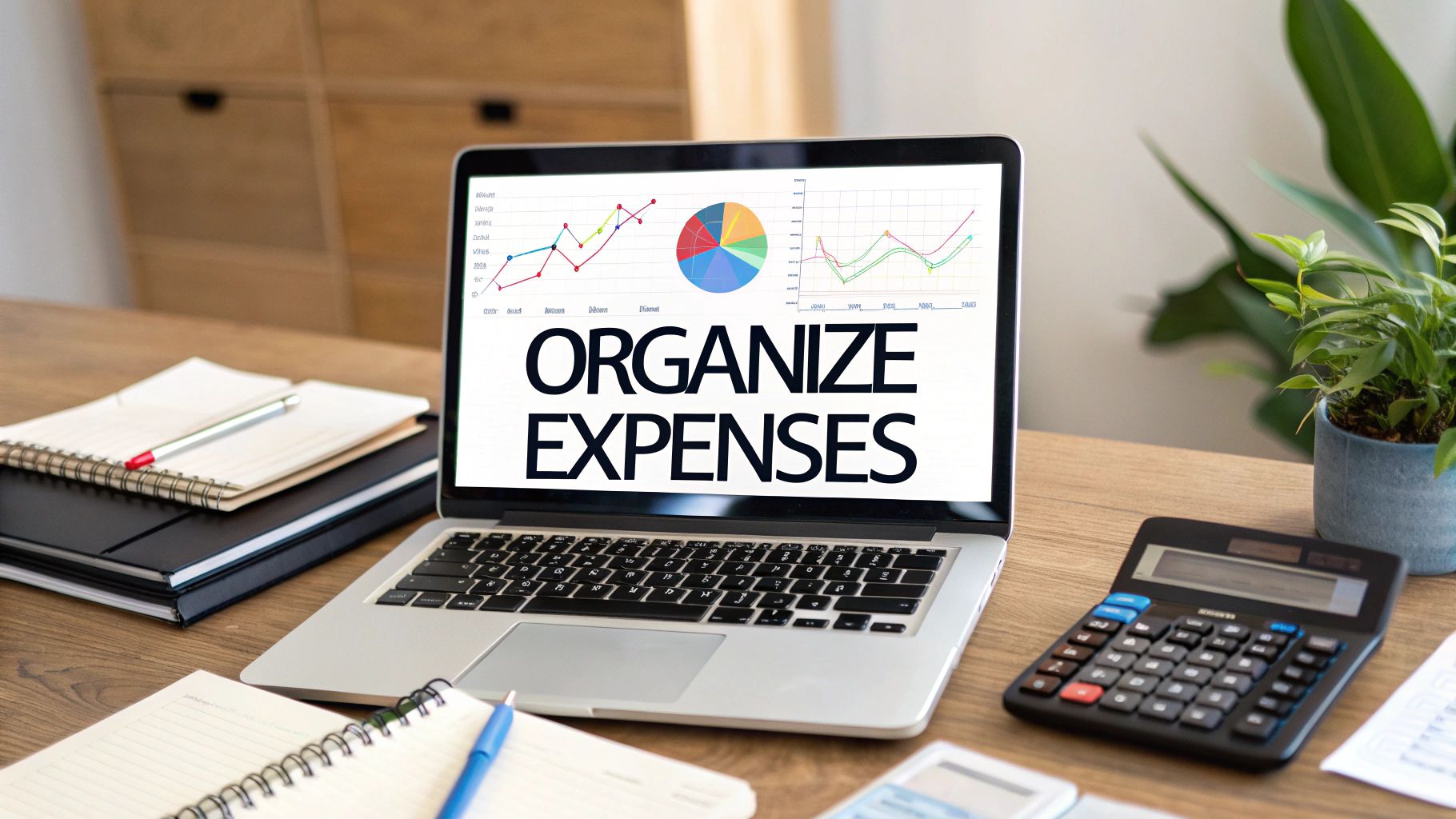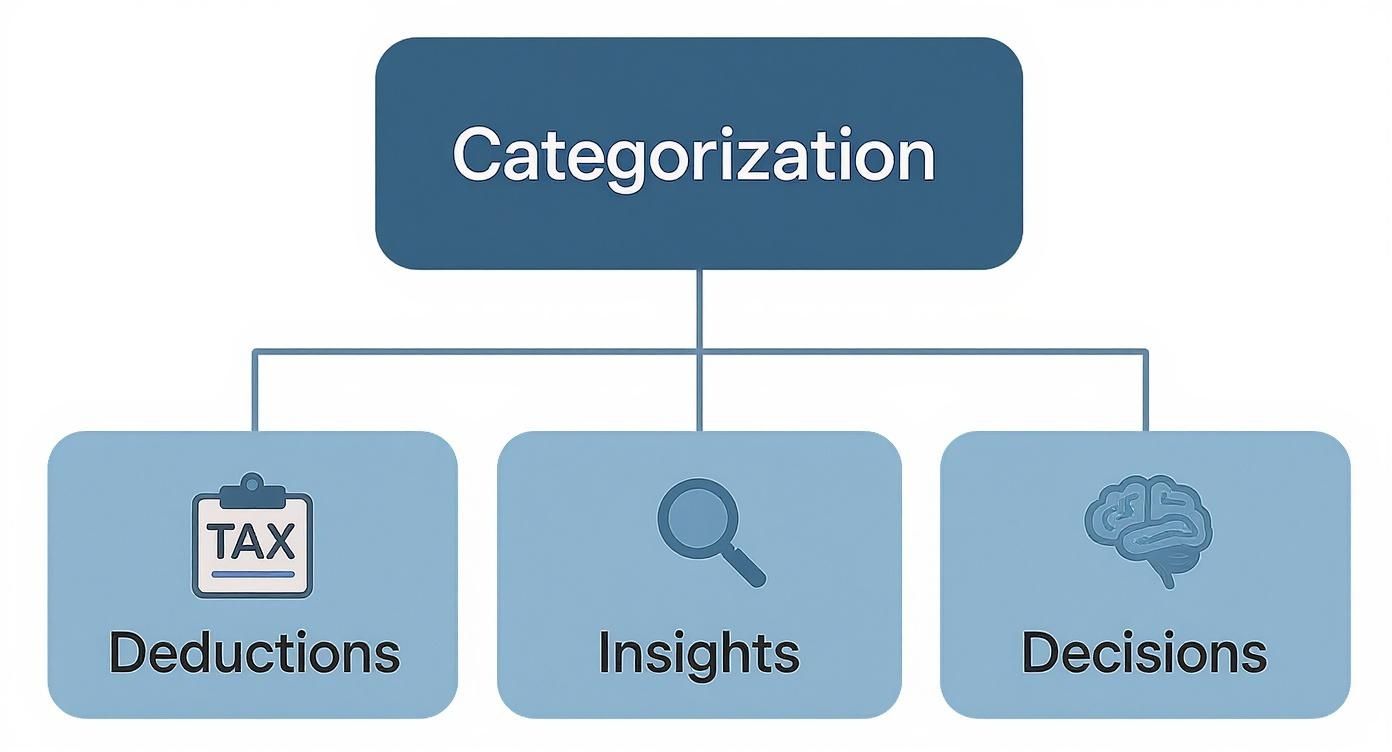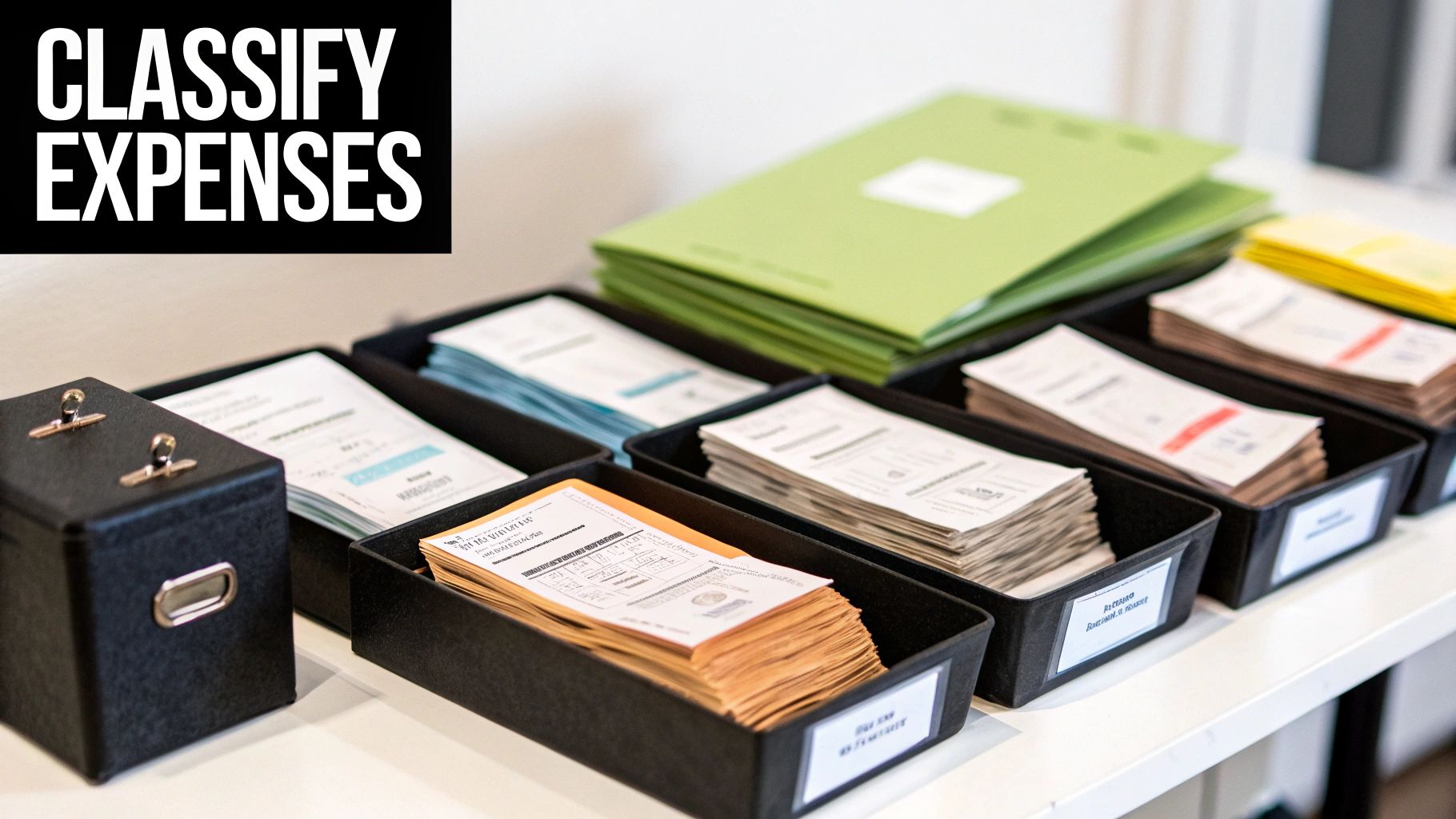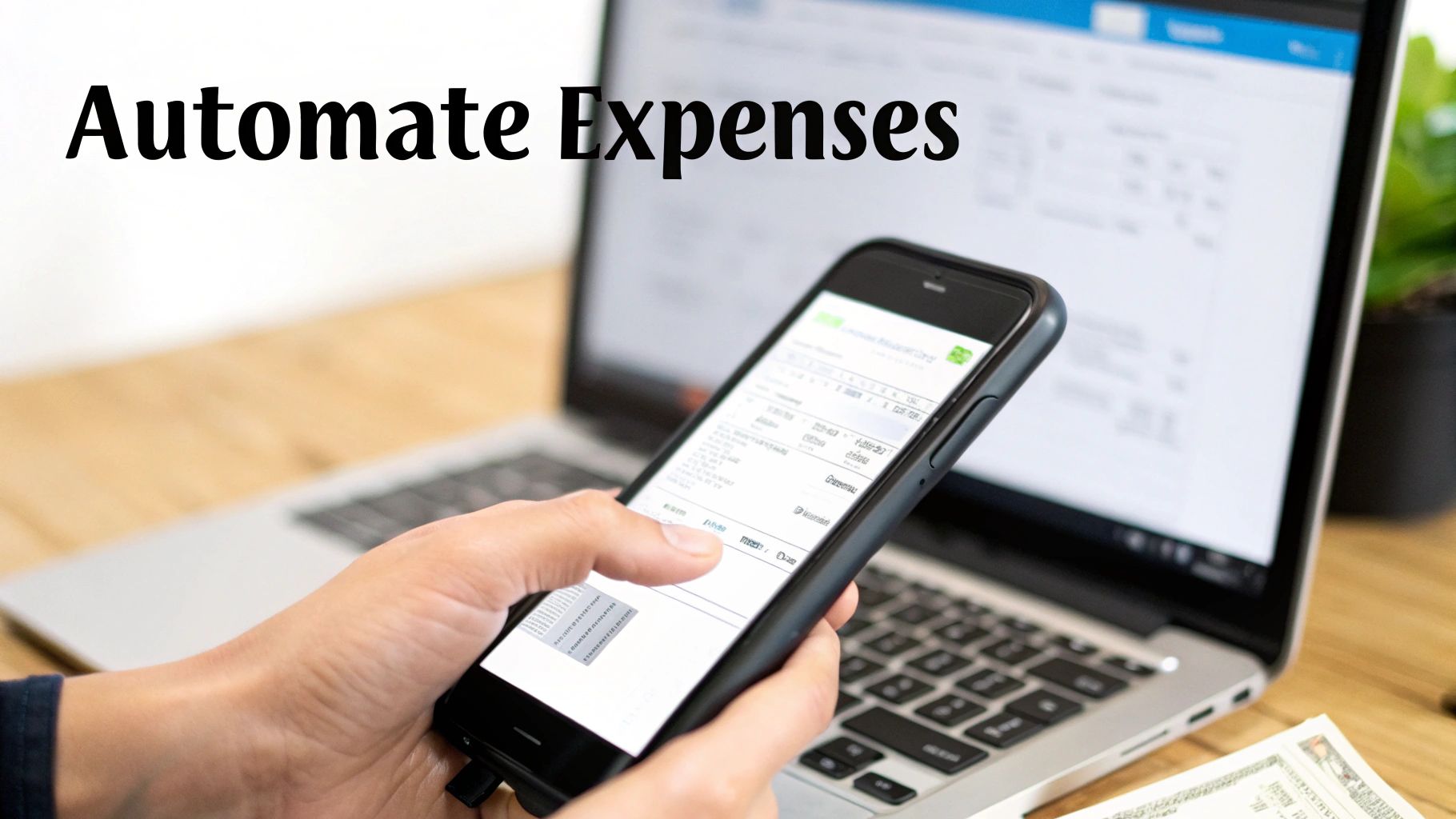How to Categorize Business Expenses The Right Way
Learn how to categorize business expenses with our guide. Discover practical tips for organizing your chart of accounts and tracking spending for tax season.
Tags

Think of categorizing your business expenses as creating a set of buckets for your spending. You’ll have a bucket for Marketing, another for Utilities, one for Travel, and so on. The goal is to build a logical framework - often called a Chart of Accounts - that makes sense for your specific industry and how you run your business.
Why Smart Expense Categorization Is a Game Changer
It’s easy to write off expense tracking as just another bookkeeping chore, but that’s a huge mistake. When done right, it's actually a powerful strategic tool that gives you a crystal-clear picture of your company's financial health. Knowing exactly where every dollar goes moves you from simply tracking money to actively managing it.
This shift has a real impact on your bottom line. An organized system is your best friend when it comes to maximizing tax deductions, ensuring you never miss out on claiming expenses like software subscriptions or professional development fees. For a deeper look at why this kind of financial record-keeping is so critical, check out this great resource on understanding the core importance of bookkeeping.
More Than Just Tax Prep
Good categorization goes way beyond getting ready for tax season. It hands you the clarity you need to make smarter budget decisions that actually drive growth. Suddenly, you can answer critical questions in a heartbeat:
- •Are we pouring too much money into marketing channels that aren't delivering?
- •Why did our utility bills spike this quarter?
- •Which team is spending the most on travel, and is it justified?
Without clear categories, the answers to these questions are lost in a messy spreadsheet. Imagine a marketing agency with a massive "Miscellaneous" expense line. It could be hiding the fact that one of their software subscriptions just doubled in price. By creating a dedicated "Software & SaaS" category, they’d spot that increase immediately and be able to do something about it.
I’ve personally seen businesses completely turn their profitability around just by getting their spending organized. A clear system exposes waste, shines a light on smart investment opportunities, and prevents those nasty financial surprises down the road.
Ultimately, knowing how to categorize your expenses isn’t just about staying compliant. It's about building a financially smart and resilient company. It gives you the data you need to steer the ship with confidence, turning your financial history into a roadmap for the future. This kind of structure helps you sidestep costly errors and build a much stronger, more predictable financial foundation.
Setting Up Your Chart of Accounts From the Ground Up
Think of your Chart of Accounts as the financial DNA of your business. Rather than trying to cram your unique operations into a generic, one-size-fits-all template, building one from scratch gives you a structure that actually reflects how you make and spend money. It’s all about creating a system that brings you clarity, not confusion.
A well-built Chart of Accounts will give you a crystal-clear view of where every single dollar is going. The trick is to create categories that are specific enough to give you real insights but broad enough that you aren't drowning in pointless detail.
First, Know Your Core Expense Types
Before you start creating dozens of individual categories, you need to understand the main "buckets" where all your expenses will live. This top-down approach keeps your accounts organized and logical from the very beginning.
- •Cost of Goods Sold (COGS): These are the direct costs of making what you sell. If you run a bakery, this is your flour and sugar. For a SaaS company, it might be the cost of hosting your application on servers.
- •Operating Expenses (OpEx): These are the essential costs of keeping the lights on, whether you make a single sale or a thousand. We're talking about things like rent, marketing spend, your team's salaries, and utilities.
- •Capital Expenditures (CapEx): This bucket is for major purchases of assets that will benefit your business for more than a year - think company vehicles, heavy machinery, or an office building. These items aren't written off immediately; they're depreciated over their useful life.
Getting these three buckets right is the first step toward building a system that doesn’t just help you at tax time but also gives you powerful insights into your business's health.
A mistake I see all the time is businesses lumping every "operational" cost into one giant category. You absolutely have to separate your COGS from your OpEx if you want to calculate your gross profit margin accurately and truly understand your company's core profitability.
This infographic breaks down why getting your categories right is so critical for everything from finding tax deductions to making smarter financial moves.

As you can see, categorization isn't just about tidy bookkeeping. It's the engine that drives meaningful financial analysis and helps you plan for the future.
Pinpointing Your Business's Unique Categories
Alright, now it’s time to get into the specifics. Start by brainstorming every single way your company spends money. A marketing agency’s expense list will look wildly different from a construction company’s. For instance, if your team is always on the road, you'll need detailed categories for flights, hotels, and client meals.
This level of detail is crucial, especially for variable costs like travel. With business travel costs climbing 14% to 15% each year - and some projections showing a shocking potential increase of up to 58% in 2025 - you can't afford to be vague. Separating fixed costs like airfare from more fluid expenses like meals gives you much tighter control over your budget.
To get the ball rolling, here’s a foundational list of common expense categories every business should consider. Use this as a starting point to build out your own Chart of Accounts.
Core Business Expense Categories and Examples
| Category Type | Specific Category Name | Common Examples |
|---|---|---|
| Operations | Office Rent & Utilities | Lease payments, electricity, internet, water |
| Operations | Software & Subscriptions | CRM software, accounting tools, project management apps |
| Operations | Office Supplies | Paper, pens, toner, cleaning supplies |
| Marketing | Digital Advertising | Google Ads, social media ads, sponsored content |
| Marketing | Content & SEO | Freelance writers, SEO agencies, keyword research tools |
| Personnel | Payroll & Salaries | Employee wages, bonuses, commissions |
| Personnel | Contractor Payments | Fees for freelancers, consultants, and independent contractors |
| Travel | Transportation | Airfare, train tickets, ride-sharing services |
| Travel | Accommodation & Meals | Hotel stays, per diems, client dinners |
This table isn't exhaustive, but it should spark ideas for what makes sense for your specific operations. The key is to create a structure that feels intuitive to you.
Choosing the right platform can make this entire process feel less like a chore. If you're exploring your options, check out our guide on the best accounting software for small businesses.
Navigating Common (and Confusing) Expense Categories

Alright, you’ve got your Chart of Accounts set up. Now for the fun part: actually using it. This is where things can get a little fuzzy in the real world. Is that coffee with a potential client a "Meals" expense or "Marketing"? Where on earth do you stick that recurring software subscription?
The goal here is to build a system that’s so second-nature you don't even have to think about it. Consistency is everything - it’s what leads to clean reports and making sure you’re getting every deduction you deserve.
Let's walk through some of the most common categories that trip people up so you can classify them with confidence.
The Nuances of Business Travel
Business travel has to be one of the trickiest areas. A single trip can spin off a dozen different types of expenses, and it’s a category that’s only getting bigger. Global spending on business travel is projected to climb to around $1.57 trillion by 2025, with flights eating up a massive chunk of that. For a deeper dive into these trends, check out this great report on business travel statistics from atlys.com.
The biggest mistake I see is lumping everything into one giant "Travel" bucket. Don't do it! You'll lose all visibility. Instead, break it down.
- •Transportation: This is purely for getting from Point A to Point B. Think flights, train tickets, rental cars, and even the Uber you took from the airport to the hotel.
- •Accommodation: Pretty straightforward - this is for hotels, motels, and any short-term rentals you use for the trip.
- •Meals: All the food and drinks consumed while you're on the road for work. It's incredibly important to keep this separate because business meals often have specific tax rules, typically being only 50% deductible.
- •Incidentals: This is your catch-all for the small stuff. Things like parking fees, road tolls, or the subway pass you bought to get around the city.
When you separate these costs, you start to see the full story. You might realize your flight costs are under control, but your team's meal expenses are creeping up. That’s an insight you’d completely miss with a single, generic travel category.
A pro tip: Create a dead-simple expense policy document. It can be a single page that clarifies things like "coffee with a prospect goes under Marketing" or "all SaaS tools go under Software & Subscriptions." This little bit of effort can save you and your team hours of guesswork down the road.
Decoding Software, Marketing, and Meals
Beyond travel, a few other categories constantly cause headaches. If you can set clear ground rules for these, your bookkeeping will become a whole lot smoother.
Software vs. Office Supplies
This one is easier than it looks. Just ask yourself: is it physical or digital?
- •Software & Subscriptions: This is for all the digital tools that keep your business running. We're talking about your accounting software (like Tailride!), project management platforms, and your CRM subscription.
- •Office Supplies: This is for the tangible stuff you can hold in your hand. Paper, pens, printer ink, Post-it notes - you get the idea.
Marketing & Advertising vs. Meals & Entertainment
The line here often comes down to one thing: intent. Were you trying to win new business, or were you nurturing an existing relationship?
- •Marketing & Advertising: Think of this as your "customer acquisition" bucket. It's for expenses aimed squarely at attracting new clients. This includes your social media ad campaigns, printing flyers, sponsoring an event, and yes, even the cost of that coffee you bought for a sales prospect.
- •Meals & Entertainment: This is more for internal team lunches or taking an existing client out to dinner. The main goal is relationship management, not a direct sales pitch. Keeping this separate is absolutely vital for tax season.
Best Practices for Consistent Expense Tracking
Having a well-organized Chart of Accounts is a great first step, but the real power comes from using it consistently. The secret to reliable financial data isn't some complex formula; it's discipline. It’s about creating a clear process that everyone on your team can understand and actually follow.
Without that consistency, even the most perfect categories will start to fray at the edges, leaving you with a messy, untrustworthy picture of your finances.
The whole point is to make accurate tracking feel like second nature, not a month-end nightmare. You want to build simple, repeatable habits so that every dollar spent lands in the right bucket, every single time. Over the long haul, this is what turns your expense data from a simple historical record into a powerful tool for making smart business decisions.
Create a Simple Expense Policy
You don’t need to write a fifty-page document that gathers dust on a shelf. Honestly, a simple one-pager can make all the difference, especially when you have a team. This guide should offer clear, real-world examples of where common expenses actually go.
Think of it like a cheat sheet. For example:
- •"Client Coffee Meetings" always get filed under Marketing & Sales.
- •"Team Lunches" should go into Employee Morale & Welfare.
- •All recurring payments for digital tools belong in "Software & SaaS Subscriptions".
This kind of straightforward guidance removes the guesswork. It empowers your team to categorize their own spending correctly, which saves you hours of tedious cleanup work down the road. It also means that when you pull a report, you’re truly comparing apples to apples.
For a deeper dive into the fundamentals, check out our guide on how to track business expenses effectively.
Set aside just one hour each month for a financial review. Make it a non-negotiable meeting with your data. This is your chance to spot miscategorized items, see spending trends, and tweak your budget before small leaks turn into big floods.
Handling One-Off and Unusual Expenses
So, what do you do with that one-time consulting fee or the purchase of a weirdly specific piece of equipment? These outliers can easily mess up an otherwise clean system. The key is to have a plan for them before they happen.
Resist the urge to just dump them into a generic "Miscellaneous" category. That’s where good data goes to die.
Instead, ask yourself: could this expense, however rare, happen again? If the answer is yes, it’s probably worth creating a new, specific category for it. Something like "Professional Consulting Services" or "Specialized Equipment Purchase" keeps your main categories pristine and your reporting laser-focused.
Adapt as Your Business Evolves
Finally, always remember that your expense categories aren't carved in stone. The system that was perfect for your two-person startup won't cut it when you grow into a twenty-person team. Your spending will naturally change as you launch new products, expand into different markets, or bring on new departments.
Make it a habit to revisit your Chart of Accounts at least once a year. You might realize you need to add new categories (like "Research & Development") or break down broader ones into more detail (like splitting "Marketing" into "Paid Ads," "Content Creation," and "Events"). This proactive approach ensures your financial tracking system grows right alongside your business, always giving you the clarity you need to move forward.
Letting Automation Handle Your Expense Categories

Let’s be honest: manually sifting through stacks of receipts and transaction logs is a soul-crushing task. It's not just tedious; it's a surefire way to make mistakes and waste valuable time. This is where modern expense tools completely change the game. By plugging directly into your business bank accounts and credit cards, they can categorize transactions the second they clear.
This real-time classification puts an end to the dreaded month-end scramble. Instead of losing a few days trying to match receipts to bank statements, you get an up-to-the-minute, accurate view of where your money is going. If you're looking to really dial in your expense management, you can find some great insights from Vibe Accounting on what to look for in a system.
Teach Your System with Smart Rules
One of the most powerful tricks up automation's sleeve is the ability to create "smart rules." Think about all your regular payments - that monthly Adobe subscription, the weekly team lunch order, or your quarterly web hosting bill. These are perfect candidates for automation.
With a platform like Tailride, you can set up a simple rule that automatically sorts any charge from a specific vendor into the right category.
- •Vendor: "Google Ads" → Category: Digital Advertising
- •Vendor: "Amazon Web Services" → Category: Software & SaaS Subscriptions
- •Vendor: "FedEx" → Category: Shipping & Postage
Once you set these rules, they handle the bulk of your routine expenses without you ever having to touch them. It keeps everything consistent and accurate, freeing you up to think about the bigger financial picture.
Ditch the Shoebox with Receipt Scanning
The days of hoarding a shoebox full of faded paper receipts are long gone. Thank goodness. Modern expense platforms use Optical Character Recognition (OCR) technology to scan and digitize receipts in an instant. Just snap a photo with your phone or forward an email receipt, and the system takes it from there.
The AI pulls out the key info - vendor, date, and total amount - and then automatically pairs the receipt with its matching transaction from your bank feed. This creates a complete, audit-ready record for every single expense, which is a lifesaver come tax time. This is a core part of effective accounting process automation.
Automation doesn't just save time; it creates a single source of truth for your finances. When every transaction is automatically categorized and supported by a digital receipt, you eliminate the guesswork and build a financial record you can truly trust.
Keeping Up with Economic Changes Automatically
Expense categorization isn’t a set-it-and-forget-it deal forever; it needs to adapt as the economy changes. For example, rising costs in major cities have pushed many companies to rethink their meal allowances and per diem rates to keep them realistic.
A smart system can spot these trends for you. By analyzing spending patterns across different regions and vendors, it can flag when certain expenses are consistently running higher than budgeted. This data allows you to proactively tweak your budgets and expense policies before things get out of hand.
Got Questions About Expense Categories? Let's Clear Things Up.
Even the most seasoned business owners run into tricky situations when categorizing expenses. It's totally normal. Let's walk through a few of the questions that come up time and time again, so you can feel confident in your process.
Can I Still Write Off Business Expenses if I Take the Standard Deduction?
Yes, you absolutely can! This is probably one of the most common points of confusion I see.
It helps to think of them as two completely separate buckets. The standard deduction is for your personal income tax, the one you file with your Form 1040. Your business expense deductions, however, are what you use to figure out your business's profit on a form like a Schedule C.
Essentially, you subtract your business expenses from your business income first. Whatever profit is left over is what flows through to your personal return, where you then decide whether to take the standard or itemized deduction. They don't cancel each other out.
Seriously, How Long Do I Need to Hang Onto Receipts?
The official IRS line is to keep records for three years from the date you filed your tax return. That’s the window they typically have to come back and ask questions.
But there's a big "however" here. If you're dealing with assets you depreciate - like a work truck, major equipment, or property - you need to keep those records for as long as you own the asset, plus another three years after you've sold it or fully depreciated it.
Honestly, with digital tools, it’s so easy to just keep everything indefinitely. A quick scan or a photo and you've got a permanent record.
A digital, audit-ready trail is non-negotiable these days. It’s not just about ticking a compliance box; it's about having solid proof of every dollar you spent. Trust me, that proof can save you a world of pain and potential penalties down the road.
What's the Real Difference Between an Operating and a Capital Expense?
Getting this right is fundamental to having financials that actually make sense.
Here’s the simple breakdown:
- •Operating Expenses (OpEx): These are the everyday costs of keeping the lights on. Think of things you pay for regularly, like rent, software subscriptions, payroll, and fuel. You write these off in the same year you pay for them.
- •Capital Expenses (CapEx): These are the big-ticket items that will last and provide value for more than a year. We're talking about buying a building, a new vehicle, or that expensive piece of machinery. You don't write off the full cost at once. Instead, you depreciate it, spreading the deduction over the asset's useful life.
Keeping these two separate gives you a much clearer picture of your company's immediate profitability versus its long-term assets.
Ready to stop guessing and start automating? Tailride connects to your accounts to capture and categorize every expense automatically, creating a perfect, audit-ready trail without the manual work. See how Tailride can transform your bookkeeping.